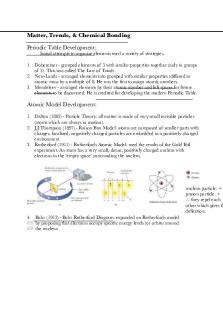Chemistry Unit 1 Electronegativity and Polarity PDF

| Title | Chemistry Unit 1 Electronegativity and Polarity |
|---|---|
| Author | Jenna Stewart |
| Course | Chemistry |
| Institution | Central Peel Secondary School |
| Pages | 3 |
| File Size | 115.1 KB |
| File Type | |
| Total Downloads | 18 |
| Total Views | 155 |
Summary
Practice material on electronegativity and polarity. There are fill in the blanks....
Description
SCH3U- Unit 1
Name:________________________
Electronegativity and Polarity Remember:
Electronegativity is the ability of an ____________________ atom, when bonded, to ___________________ bonding electrons to itself this determines how electrons are _________________ in a chemical bond It is measured using a scale (_________________) An element with a high electronegativity is _________________ at pulling a pair of electrons toward itself, whereas an element with a __________ electronegativity is not. _________________ has the highest value on the periodic table, while _______________ the lowest.
Determining if a Compound is Ionic or Molecular
We can determine if a bond is ionic or covalent/molecular by use of the _________________________ in the electronegativity (__________) values of the two elements involved. Whether the difference is positive or negative does not matter-only the _______________________ of the difference, so the equation uses an absolute value: NaCl ΔEN = │ │
Non polar Covalent Bond
When electrons are __________________ between 2 atoms, a __________________ bond is formed. If the atoms are _________________, e.g. Cl2, the electrons are shared __________________ (non-polar) ΔEN =
Polar Covalent Bond
If the electrons are shared between 2 _________________ atoms, the sharing is ____________________ The bonding electrons spend ______________ _____________ near the more electronegative atom ΔEN =
SCH3U- Unit 1
Name:________________________
This is not a complete transfer of an electron from hydrogen to fluorine; it is merely a drifting of electrons toward fluorine When a charge separation of this type is present, the molecule possesses an electric dipole, so called “_______________________” and the bond is called a ________________________________________________
Example: Water (H2O)
∆EN = 1.24 (which is between 0.4 and 1.7)
Oxygen = a slightly negative charge Hydrogen = a slightly positive charge
Since the hydrogen does not completely transfer its electron to the oxygen, the their respective charges are indicated as ________________ (the indication of partial positive charge) and _______________ (indication of partial Negative charge).
Electronegativity Differences The absolute value of the difference in electronegativities of two bonded atoms provides a measure of polarity of a bond. The greater the difference, the more polar the bond.
SCH3U- Unit 1
Name:________________________
Identify each compounds as ionic, polar- covalent or non-polar H-CI,
C-Cl
MgF2,
H2O,
NH3,
NaCl,
OH,
H2
Polar Molecules
Not all molecules with polar bonds are _________________ molecules
The overall polarity of a molecule depends on a combination of:
-
To predict the polarity of the molecule: i.
Determine if there are _________________ bonds using _____________________ value
ii.
If there are polar bonds, establish the _____________________ of the dipoles.
(A _____________ exists when two _____________ charges are separated by a short distance)
( + -) iii.
identify the _________________ of the molecule if the dipoles _________________ due to the shape of the molecule then the compound is ______________________________________ if the dipoles ______________________________ due to the shape of the molecule then the compound is _____________________
Polarity of molecule Chemical formula
Lewis diagram (polar/non-polar)
CH4 methane
CO2
H 2O...
Similar Free PDFs

Chemistry UNIT 1 Study Guide
- 3 Pages

Gr.11 Chemistry - Unit 1
- 10 Pages

Chemistry Unit 1 exam Questions
- 22 Pages

Unit 1 chemistry past papers
- 12 Pages

AP Chemistry review Unit 3 and 4
- 4 Pages

Unit 7 (chemistry 104)
- 2 Pages

IB chemistry Unit 1 Exam Questions
- 33 Pages
Popular Institutions
- Tinajero National High School - Annex
- Politeknik Caltex Riau
- Yokohama City University
- SGT University
- University of Al-Qadisiyah
- Divine Word College of Vigan
- Techniek College Rotterdam
- Universidade de Santiago
- Universiti Teknologi MARA Cawangan Johor Kampus Pasir Gudang
- Poltekkes Kemenkes Yogyakarta
- Baguio City National High School
- Colegio san marcos
- preparatoria uno
- Centro de Bachillerato Tecnológico Industrial y de Servicios No. 107
- Dalian Maritime University
- Quang Trung Secondary School
- Colegio Tecnológico en Informática
- Corporación Regional de Educación Superior
- Grupo CEDVA
- Dar Al Uloom University
- Centro de Estudios Preuniversitarios de la Universidad Nacional de Ingeniería
- 上智大学
- Aakash International School, Nuna Majara
- San Felipe Neri Catholic School
- Kang Chiao International School - New Taipei City
- Misamis Occidental National High School
- Institución Educativa Escuela Normal Juan Ladrilleros
- Kolehiyo ng Pantukan
- Batanes State College
- Instituto Continental
- Sekolah Menengah Kejuruan Kesehatan Kaltara (Tarakan)
- Colegio de La Inmaculada Concepcion - Cebu








